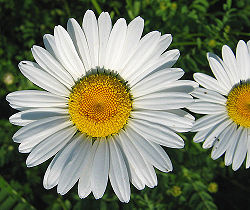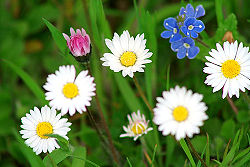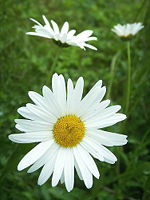Oxeye daisy
| Oxeye daisy |
|---|

|
| Scientific Classification |
|
| Binomial Name |
|
Leucanthemum vulgare |
The oxeye daisy is a species of daisy with the scientific name Leucanthemum vulgare. They are also known as white daisies, field daisies, and marguerite. The flower has been used to symbolically represent “patience”.[1] They originate from Europe and Asia, but today are considered an invasive species that has spread to become a weed in 40 countries, from Africa to Australia and North and South America. They can live in many environmental conditions; and are commonly found in areas with poor soil nutrients. Today they are used in medicine, salads, and so on. [2]
Anatomy
The oxeye daisy grows from 1 to 3 feet high, and has daisy-like flowers with a large central yellow disk and 20~30 white petals.[3] The leaves from 1.5 to 6 inches long, have a serrated edge (jagged), and somewhat resemble a lance. [4] The root system is fibrous, and has rhizomes (underground runners) for asexual reproduction. [5]
Reproduction
The oxeye daisy has two ways to reproduce, which are vegetatively (asexual) and by seed (sexual).
It grows horizontal stems, gets a stolon, and after that, the stolon divides into many parts, resulting in a new plant. Insects are important in transferring pollen, which helps maintain genetic diversity. From june through august one oxeye daisy produces 1300 to 1400 seeds. Most oxeye daisy’s seed can wait up to 6 years.[6]
Ecology
The oxeye daisy is native to Europe and Asia. [7]In USA, we can see lots of oxeye daisy from most state accept some cities. The oxeye daisy can live in many different environmental conditions, so we can see it in most state. Also, they’re found on the rail roads, meadows, and waste areas. However we can not see them in Wyoming and Montana, because they attacked grasses and pasture. The oxeye daisy propagates bacteria or some fungi in grasses and pasture. Therefore people try to decrease the oxeye daisy populating in those states.[8]
History
The oxeye daisy came from Europe and asia, in 1890it was first found in Montana. The first oxeye daisy was known as contaminant however it became common plant like daisy because it was pretty, and can be used as medicine for whooping cough, and other sicknesses, many people started its cultivation, today it is used in many parts of our lives. For example, it was medicine for coughs, and one can make tea from the leaves, also many people put the oxeye daisy into their salads. Like this, it becomes a common flower in our life.[9] Now we can see the oxeye daisy from anywhere, because most states have this flower, however some states, such as Wyoming and Montana, don’t want to cultivate them. So grasses decrease and disappear. Also, animals doesn’t want to eat them, affecting pastures and farmland.[10]
Gallery
 Browse |
References
- Oxeye Daisy unknown Author. Oxeye Daisy.
- Oxeye Daisy: Chrysanthemum leucanthemum unknown Author. Virginia Tech Weed Identification Guide.
- Ox-eye Daisy unknown Author. Connecticut Botanical Society.
- Leucanthemum vulgare Lam.oxeye daisyunknown Author. USDA
- Oxeye Daisy Leucanthemum vulgare Lam. Written Findings of the State Noxious Weed Control Board.







